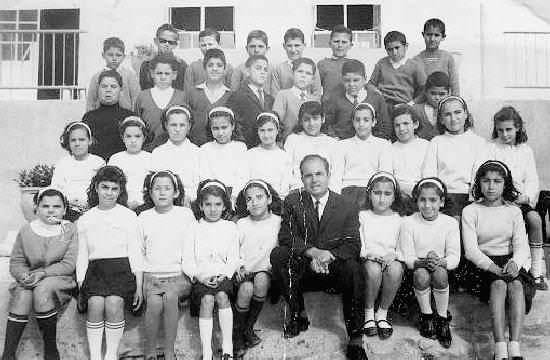
Greek School Uniforms: Chronology--1950-74

Figure 1.--This school portrait shows a Demotiko (elementary school) probably in the 1960s. Some souvenir pictures can be misleading because teachers often asked their
students to wear specified clothes in order to look uniformed. The consistency here, however, suggests that the school did have a uniform. Notice that only one girl wears a smock.
|
There were two levels of schooling during 1950-74 in Greece. "Demotiko" (elementary school) for children of ages 6-11 and "Gymnasio" (high school) for children of ages 12-17. Schools operated 6 days a week during 8-12 in the morning and 3-5 in the afternoon. Besides the summer, the school holidays were Christmas, Easter, "Kathara Deftera", Independence day and "Ochi" day.
Demotiko
The school uniform for the Demotiko consisted of blue smock with white
collar for girls and boys. The term used for the school uniform in Greece is "Scholiki podia" or simply "Podia" which means "Apron". This was the standard uniform but in many cases it was acceptable for boys to wear a blue sweater with blue or grey short or long trousers instead. In poor and/or isolated regions teachers and school authorities tolerated non uniformed students. As a result almost none of the children in those areas wore
a uniform in school.
Gymnasio
For the Gymnasio school uniforms were mandatory. While girls still had to
wear the blue smock with the white collar, boys had to wear a simple long or
short trousers with a shirt/sweater/blazer (the combination varied on
weather conditions and/or economic prosperity of the family) and a necesairy
cap with the emblem of an owl (symbol of wisdom in ancient Greece). Boys had to wear the cap in and outside school. If they were caught without the cap they would be punished at school. The cap was abolished in 1964 from the reformist government of George Papandreou. As late as the 1950s, most of the students at a Gymnasio were boys. Note that in the 1953 photograph on the previous page that there are many more boys than girls. If I am not mistaken the girls were no more than 7 while the boys were more than 20. A HBC reader reports, "This is because in 1953 most girls would quit school after elementary to
help their mothers in their hose and/or get married. It wasnt required for citizens to enroll to gymnasio back then, so a lot of boys and most of the girls would quit just after demotiko. My grandmother didnt enroll and neither did my oldest aunt. My grandfather did not enroll either, but that was only because of World War II."
Christopher Wagner

Related Chronolgy Pages in the Boys' Historical Web Site
[The 1880s]
[The 1930s]
[The 1940s]
[The 1930s]
[The 1940s]
[The 1950s]
[The 1960s]
[The 1970s]
[The 1980s]
Related Style Pages in the Boys' Historical Web Site
[Long pants suits]
[Short pants suits]
[Socks]
[Eton suits]
[Jacket and trousers]
[Blazer]
[School sandals]
Navigate the Boys' Historical Clothing Web Page
[Return to Main Greek school uniform chronology page]
[Return to Main national school uniform page]
[Return to Main Greek page]
[Introduction]
[Activities]
[Biographies]
[Chronology]
[Clothing styles]
[Countries]
[Bibliographies]
[Contributions]
[FAQs]
[Glossaries]
[Satellite sites]
[Tools]
[Boys' Clothing Home]
Created: April 26, 2002
Last updated: April 26, 2002



